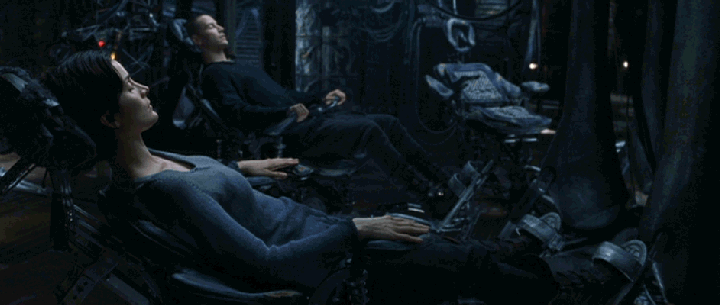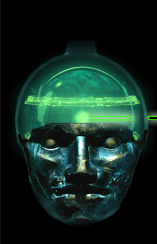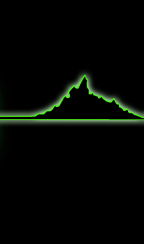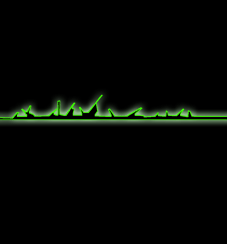The issues of control, and being controlled, often culminate simultaneously within those occupying seats or positions of power, whereby they may issue orders and generate terror within the civilians of these future cities. Yet, we so often see the corruption that occurs in using these positions, in such a way that the power begins to control the apparent rulers themselves.
The chairs of The Matrix, allowing the heroes to ‘jack in’ to the computer world, give them the capacity to demonstrate incredible, super-human abilities within the Matrix, but, while doing so, they must ironically be completely restrained in the real world.
Hel, the machine-man of Metropolis, sits in its throne before being activated, demonstrating before it makes any action, that it is already in a posture of great power. Interestingly, it is this chair that delivers the robot its electrical energy to bring it to life, literally being born into the throne.
This same notion of throne, and connection to the city, is repeated in the subsequent films to the original Metropolis, as with The Matrix, Akira and the animated Metropolis, where in each case, there is a direct connection between the principal figures and their surroundings, as these figures, in their respective 'thrones', are plugged into the great cities they now oppose. In all cases, however, the very act of connecting these individuals to their surroundings, suddenly shifts their positions, such that the nature of the cities themselves envelope and absorb these figures into the city fabric.
Counteracting the aforementioned figures, who are usually part of an uprising against authority, the more common picture of authority, itself, as found in the dystopic city, usually occupies a similar central position of control in the city. This is exemplified wit the characters Fredersen, and Tyrell, of Metropolis and Blade Runner respectively. Of course, occupying these postures of power, usually makes the individuals of control, a central target for the rebellious figures, often themselves having been created by these governing personalities.
The model of a council in more contemporary films, shows itself to be common as a centre of government in the dystopic future city. Interestingly, the councils form in both those supporting and opposing the central control of these cities. Though these arrangements suggest more just or fair decision making, corruption may take over in much the same way, often with even more devastating effects through the syncronized effects of those in the council. This is best exemplified by the grim figures of Dark City, who act collectively as a controlling force by tranforming the city above through their combined mental, tele-kinetic abilities acting in unison. In Appleseed, the technologically enhanced council of elders, decide they must end human civilization, having been surpassed by their own creation of genetically engineered beings, the ‘Bioroids’, thus demonstrating the self-destructive nature many of these governments exhibit in the apparent utopias, that are soon transformed into complete nightmares, when controlling or even genocidal choices are made for the public.



The command console is yet another image of a technological interface between the individual and the environment. Much of the capacity for affectation of these systems is found in the relaying of information from the surrounding environment, such that the figure within effectively connects to all of their environs, or all of that on which they are operating. This extends the self into the environment of interest, in a sort of techno-empathetic interconnection. This position gives the operator a heightened level of control over the environment, as the envrionment itself begins to envelope the being within.
Often in this genre of film, we find figures, usually the heroes (even if understated) confronting those in positions of power. An ultimate example of this is Neo’s confronting 'The Architect', the maker of the Matrix, in what appears to be the ultimate control centre; a hemisphere of screens, relaying all images of the digital world. This confrontation reveals the absolute calculatedness of the Matrix’ construction, but further unveils its weakness of ‘choice’, which Neo, standing as the example of the human race, exhibits through his own nature, showing a strange incompatibility and co-dependence of natural freedom, and calculated, technological determinacy.
These chairs of control, as of yet have been about connectivity with the cyber-cities of these films, but they may equally act as forms of isolation for those in them. In cases such as these, there is a retreat into the imagined environment of the mind. In Brazil, Lowry must live entirely in his dream to escape the horrors of the city, Max Renn of Videodrome finds he too can no longer discern between reality and his hallucinations. Only John of Dark City, can use this dependence on mental space to his advantage, as he is able to ‘tune’ or mentally transform his surroundings, like his oppressors. These films then show the strange, complete mental connection and simultaneous disconnect with the dystopia, by virtue of the intense isolation within the oppressive environment, such that the terrifying quality of these environs cause a complete loss of any sense of reality.
Videodrome
HOME UW School of Architecture – Jonah Humphrey





























